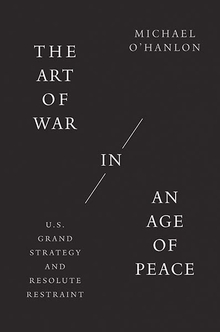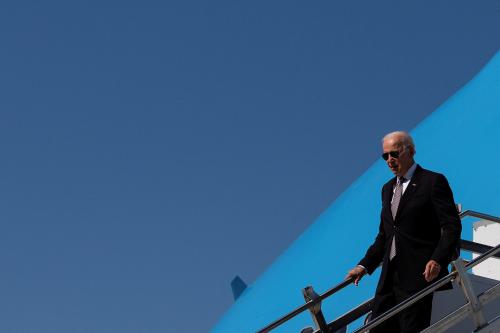This week, the Pentagon released its annual report on Chinese military and security developments over the past year. That capped a busy season for the Government Printing Office: the National Security Strategy, National Defense Strategy, Nuclear Posture Review, and Missile Defense Strategy all came out publicly last month.
All the documents, not just this most recent one, emphasize China. Although it is Russian President Vladimir Putin who is raining down death and destruction on Ukraine, issuing nuclear threats to the West, and distorting energy as well as food markets worldwide, China gets pride of place as security challenge number one — even though China has not employed large-scale military force against an adversary since its 1979 war with Vietnam. Given Beijing’s capacities, the Pentagon is convincing when it describes China as its “pacing challenge.” But we Americans have demonstrated before the veracity of the slogan that if it’s worth doing, it’s worth overdoing — and we are tending towards overhyping the China threat in a way that could raise the risks of war.
To be sure, Beijing deserves most of the blame for today’s unsettled Indo-Pacific region, with its big military buildups, threatening words and actions towards Taiwan as well as other neighbors, menacing behavior in the East China Sea and South China Sea, and increased repression at home. Indefensibly, Chinese President Xi Jinping has also given succor to Putin as the latter wages his heartless and unjustifiable war in Europe. But on several key points, the recent U.S. government reports, as well as American policy more broadly, go too far:
- The Pentagon report, like other documents, correctly criticizes Xi’s support for Putin, including the joint statement released just before Russia attacked Ukraine in February announcing that the China-Russia relationship knows no bounds. However, the relationship does in fact have bounds — and very important ones at that. To date, China has not sent weaponry to Russia during the Ukraine war, despite Putin’s requests that it do so, a point U.S. President Joe Biden once acknowledged in passing this fall. Yet the Pentagon’s 2022 Annual Report on China and other official documents, in explaining the nature of the Russia-China relationship, fail to acknowledge this crucial point.
- The Pentagon’s latest report, again accurately, complains that China’s military budget has continued to grow at roughly a 7% annual rate of late. China now spends an estimated $250 billion to $300 billion a year on its armed forces, second worldwide only to America’s nearly $800 billion. Yet Beijing’s military budget, while robust, remains at less than 2% of GDP — the level considered a minimal acceptable effort within the NATO alliance. America’s own level exceeds 3% of GDP. Of course, NATO is a defensive alliance. China’s recent behavior – from the Senkaku islands in the East China Sea, to its missile launches near Taiwan, to the creation and militarization of artificial islands in the South China Sea, to (limited but quite lethal) aggression against Indian soldiers in the Himalayas – is not generally defensive. Yet it is still important to note that China is hardly engaged in blatant arms racing.
- The Pentagon report sounds the clarion call that China appears to have the capacity, and a plan, to expand its nuclear forces from their current level of about 400 warheads to somewhere between 1,000 and 1,500 by 2035 or so. This is certainly not good news for American strategy. However, an established superpower like the United States with 5,000 nuclear warheads of its own should not be surprised that a rising superpower like the PRC may desire to have 20% to 30% of that total itself.
- The Pentagon also harps on the fact that, by ship count, China now has the world’s largest navy — generally failing to note that, because U.S. ships are typically much bigger, America’s naval tonnage exceeds China’s by a ratio of about two to one. Neither of these metrics is conclusive, and others are important too. But the frequency with which Washington complains about the number of ships in China’s navy wrongly implies that fleet size is the central standard of excellence for modern maritime capability, and that China therefore has somehow malevolently moved ahead of us in overall strength.
- Washington rightly objects to Beijing’s claim of sovereignty over the South China Sea, and the Chinese military’s proclivity to harass U.S. Navy ships there. China is indeed in the wrong with these expansive claims and dangerous actions. However, U.S. views that free transit by other nations’ navies within the economic zones of another country should always be permitted are not universally accepted themselves. For example, under its reading of the U.N. Convention on the Law of the Sea, even India believes that any country wishing to traverse the exclusive economic zones of another nation (within 200 nautical miles of the coastline, generally) should request permission for such a transit in advance. Yet we accuse Beijing of fundamentally challenging the rules-based order with its own behavior. We need to temper our anger, even as we continue the freedom of navigation operations.
- The Biden administration’s National Security Strategy prioritizes China as the “most consequential strategic competitor” of the United States. This, like the National Defense Strategy’s framing of China as the Pentagon’s “pacing challenge,” is reasonable. But in other ways, we seek too often to stir the pot. Terms like pacing challenge stand in stark contrast to the administration’s frequent and highly inflammatory use of the term “genocide” to describe China’s treatment of its Uyghur population in Xinjiang province. Beijing does commit severe repression against the Uyghurs. A recent U.N. Human Rights Council investigative report chose the correct language, determining that China has been committing “…serious human rights violations…” in its August 2022 report on the subject. Yet diluting a culture and even curtailing some reproductive rights of a minority population, however morally reprehensible, do not constitute genocide. That latter term has a potent historical meaning that conjures up images of gas chambers and mass butchery. Whatever State Department lawyers may argue, what China does in Xinjiang is terrible, but it is not genocide, and the U.S. government should stop using that term.
The China challenge is going to be with us for a long time. We need to choose our words and our strategies with calm, balance, and precision.








Commentary
Does the Pentagon report on China’s military correctly judge the threat?
December 2, 2022